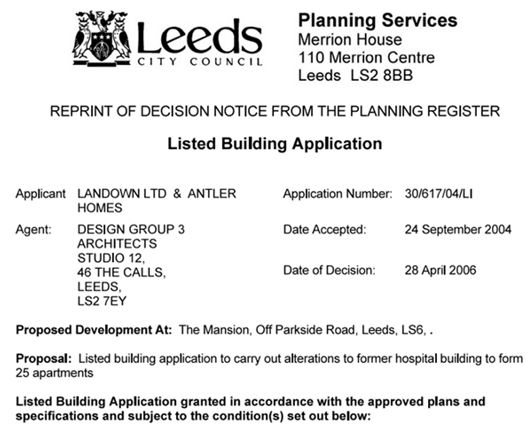Heritage at Risk Top 10 – Following on from last month’s piece on Kirkstall’s Abbey Mills, this final feature from our Heritage at Risk Top 10 for 2024/25 will focus on the once-grand eighteenth-century mansion of Meanwood Hall (also known as Meanwood Park Hospital).
Heritage At Risk: Use It or Lose It. Meanwood Hall – 10 years later & Nothing Has Changed!

In September 2015, Martin Staniforth introduced an article by Caroline Newton on Meanwood Hall, highlighting buildings at risk of being lost due to neglect or other threats. At the time, there was a call for ‘sensitive restoration’ to bring the building back into use. Ten years on, however, Meanwood Hall remains untouched, empty, and boarded up, twenty years after it was sold by the NHS to a new owner. Planning permission for conversion into 25 apartments was granted in 2006, but work has never begun. In the meantime, the building has been broken into, vandalised, and continues to deteriorate.
Just a year ago, in September 2024, the Yorkshire Evening Post published an article based on the investigations of an ‘urban explorer’ who gained access to the building and described the interior as “derelict for over 2 decades and in an extremely poor state of disrepair”. He reported that the building had become “absolutely infested with pigeons.”
Originally, Meanwood Hall stood in extensive grounds, as shown in old Ordnance Survey maps and an 1848 drawing of the hall, in which the exterior looks very much like the building we see today.

In the eighteenth-century, Leeds merchant Thomas Denison (1720-1769), purchased land in what was then part of Chapel Allerton and built Meanwood Hall as his private residence in 1762. It was rented by various tenants after his death. A North wing was added in 1814 for Joseph Lees a school master for his Gentleman’s Academy and in 1824 it was bought by wealthy banker (and twice Mayor of Leeds) Christopher Beckett (1777-1847). Beckett employed the architect John Clark to reface the main square block, adding bay windows and coping in the Italianate style in the 1830s. After his death in 1847 Beckett’s unmarried sisters, Mary and Elizabeth, continued to live at the Hall until their deaths in 1858 and 1864 respectively. The building was then rented out again, with the last known individual tenant being colliery owner R.W. Bower.
In 1919, Meanwood Hall was leased to Leeds Corporation and became Meanwood Park Hospital, a ‘colony’ for the mentally handicapped. The Corporation later bought the site in 1921. In 1941 the number of patients grew from 87 to 841, and so ‘villas’ were built in the grounds to provide accommodation for the increasing numbers.
Meanwood Park Hospital was later taken over by the NHS, and the ‘Mansion House’ (as it was then known) became an administration centre for the hospital with offices for the Matron and the Medical Superintendent and upstairs flats for medical staff. The doors to Meanwood Park Hospital finally closed in 1997 and the land surrounding Meanwood Hall was sold off to developers, followed soon after by the Hall itself. Today, Meanwood Hall is situated in the middle of a large, desirable housing estate built in the 1990s. Unfortunately, the restoration of the Hall was not linked to the new housing as enabling development, which might have prevented its current predicament.
The building is Grade II listed and the official list entry from Historic England gives details of the quality of the Hall’s interior features, all being extremely vulnerable to decay (List Entry 1375476). Leeds City Council’s Conservation Area Appraisal for Meanwood commented in 2008 “the historic Meanwood Hall is very important to the setting and history of Meanwood and the conservation area”, yet the current boarded up state of Meanwood Hall, and its neglected surroundings, has a negative impact on the local area and continues to be a cause for concern for both local residents and members of our Heritage Watch Group.
Still the question remains, what is to be done? A decade from now, will there be another article featured in a Leeds Civic Trust publication lamenting the failure to bring this heritage asset back from the brink? When buildings like this cease to be needed for their original purpose, how can we ensure they are repurposed in a timely way? What needs to change to ensure that Meanwood Hall, and other heritage assets like it, are cared for whilst a new use is found?
The power of local authorities to compulsory purchase properties like Meanwood Hall is not proving to be effective. Is the process just too difficult and costly? Should it be made quicker and easier? Should there be a national obligation and dedicated funding to restore heritage properties to new and sustainable uses? As the largest funder for the UK’s heritage, could the National Heritage Lottery Fund (and other funding bodies like it) play a greater role in addressing the issue. A serious discussion is needed to tackle this persistent problem, otherwise, sadly, nothing will change.




